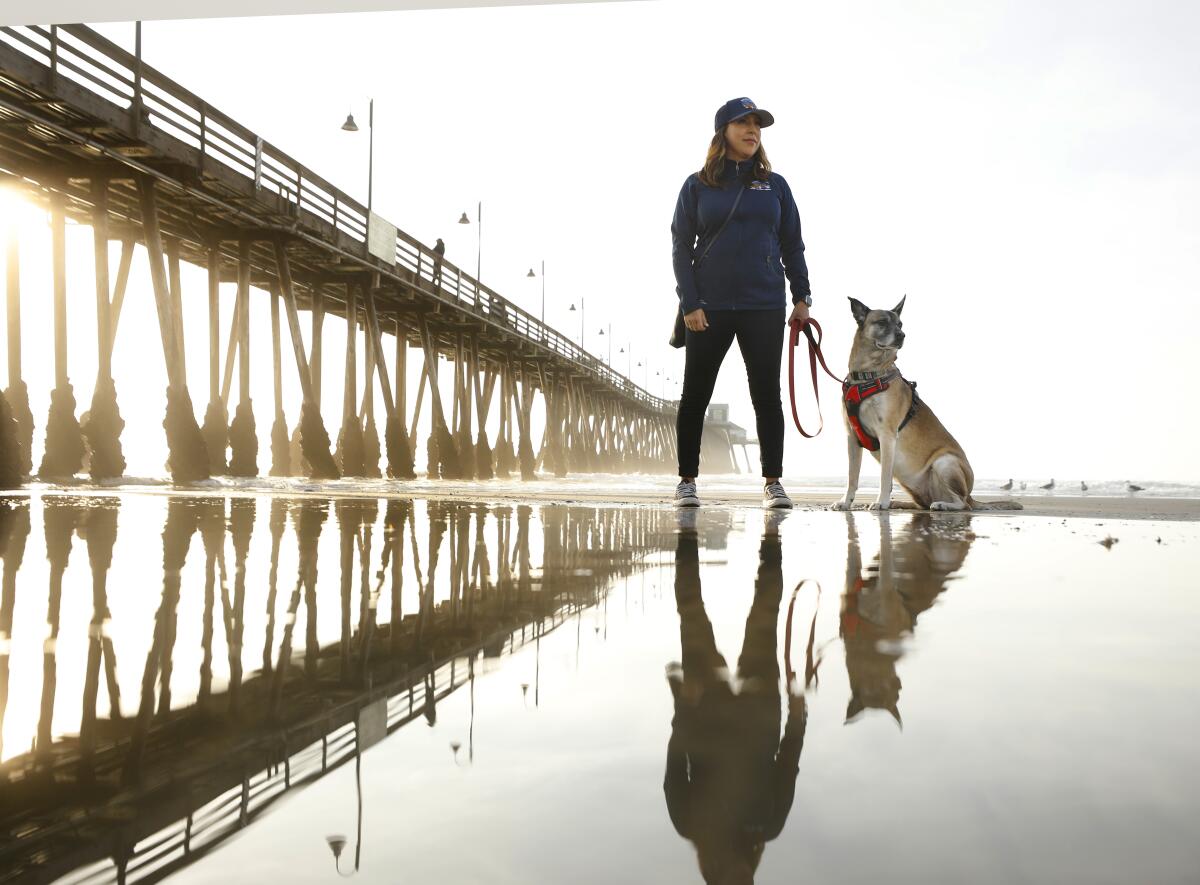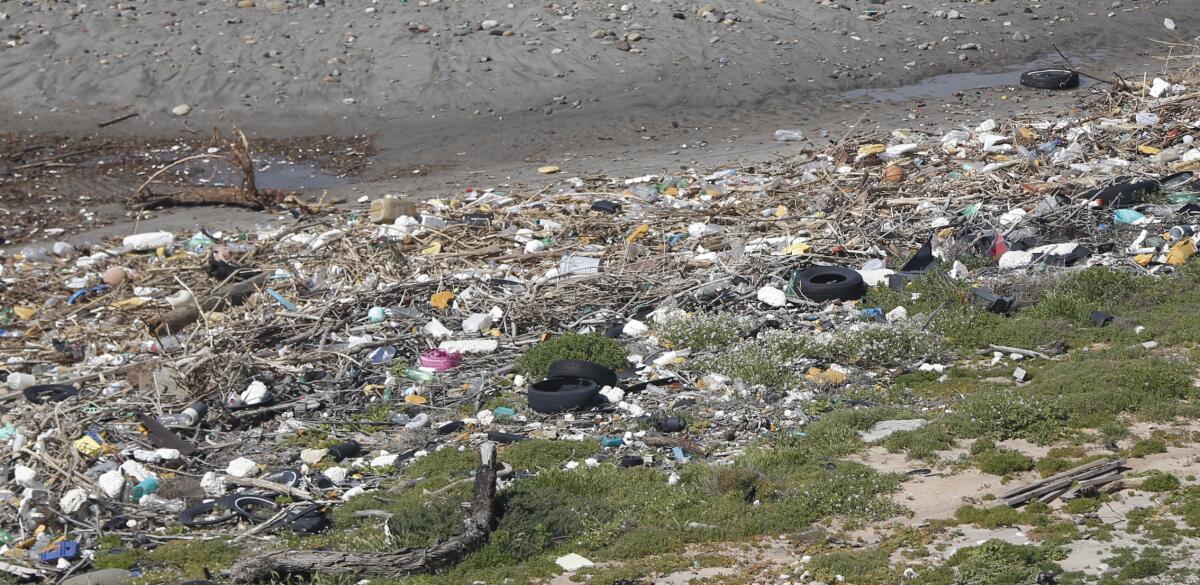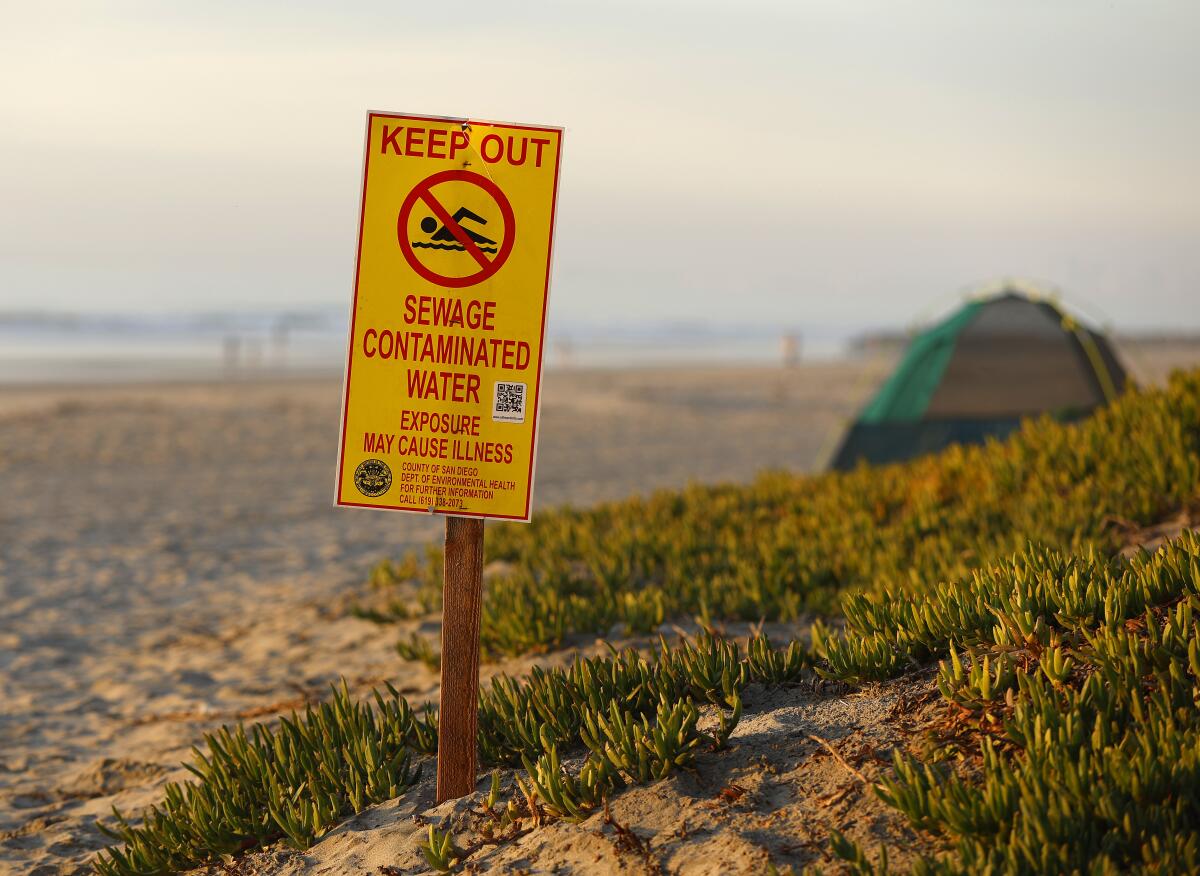Three ways Imperial Beach’s new mayor plans to tackle the Tijuana sewage crisis

Paloma Aguirre plans to leverage her experience in Washington and Mexico to address the crumbling wastewater plant that pollutes South Bay beaches
- Share via
Imperial Beach — Paloma Aguirre has fought to clean up the sewage-plagued waters of Imperial Beach for the better part of the last two decades — first as an activist and most recently as the city’s first elected woman of Mexican descent.
The city’s newly minted mayor says her highest priority next year will be working with officials in Baja California to stem the pollution that routinely spills over the border and floats up the coastline.
“It’s not just about speaking the language,” she recently told the San Diego Union-Tribune. “It’s about understanding the culture. I can navigate that.”
Aguirre was born to immigrant parents who waited tables in San Francisco. When she was 8 years old, the family moved back to their hometown of Puerto Vallarta, Mexico, where she graduated from high school.
In her early 20s, she traveled to Imperial Beach for a bodyboarding competition. It didn’t take but two years before the Mexican American was a full-time resident taking psychology classes at the University of San Diego. She would eventually become the first person in her family to graduate from college.
“I was surfing IB without a wetsuit in the middle of October,” remembered the 45-year-old. “I just fell in love with it. I was like, ‘I want to live here,’ and I never went back.”
Eventually, she met local clean water crusader Serge Dedina and got involved with his nonprofit Wildcoast. The two worked together for years on binational issues aimed at conserving coastal ecosystems.
“Paloma’s a tenacious environment advocate,” said Dedina, who served as the mayor of Imperial Beach for the last eight years. “She never hesitated in calling out people for not doing their jobs. That’s the kind of attitude that will help to fix this problem.”
Elected to the City Council in 2018, Aguirre has a master’s degree in marine biodiversity and conservation from UC San Diego’s Scripps Institution of Oceanography and briefly worked for U.S. Sen. Cory Booker in Washington, D.C.
Now as the city’s top leader, her challenge remains stopping the flow of sewage from Tijuana that routinely fouls South Bay beaches. Here are her three strategies for addressing the ongoing crisis:

Pressure Mexico to fix a crumbling plant
Aguirre said her main objective next year will be to get the governor of Baja California, Marina del Pilar Ávila, to overhaul or replace an aging wastewater facility located about six miles south of the border at a place called Punta Bandera.
The San Antonio de los Buenos treatment plant discharges up to 35 million gallons a day of raw sewage into the Pacific Ocean, according to estimates from the U.S. Environmental Protection Agency.
“I’m calling on her to schedule a meeting in January,” Aguirre said of the Baja California governor. “We need to sit down, and she needs to explain to me what the timeline to fix Punta Bandera is. Period.”
For years, environmental regulators thought sewage pouring over the border from Mexico was largely the result of heavy winter rains that flushed polluted runoff and wastewater through the Tijuana River channel into the estuary in Imperial Beach.
Then, in late 2021, researchers confirmed what lifeguards and surfers had long suspected: Imperial Beach is polluted even in the summer when ocean currents carry plumes of feces and dangerous pathogens from the plant as far north as Coronado.
Mexico has reportedly approved $140 million through 2027 to upgrade sewage pipes and other facilities in Tijuana as part of a cross-border deal with the U.S. Aguirre has argued that spending at least some of that on fixing the treatment plant would be in both regions’ best interest.
“Let’s not forget the people who constantly get sick in Tijuana and Rosarito,” she said. “I work with NGOs in Tijuana, and that’s something I hear from them constantly. Their situation is even worse because they don’t have a beach monitoring system.”
Help deliver EPA’s $630-million blueprint
The South Bay has made huge strides toward stemming the pollution since a massive sewage spill in 2017 triggered a public outcry, followed by a Clean Water Act lawsuit against the federal government.
In response, the EPA has drafted a detailed plan to address the situation, which focuses largely on rerouting some of the wastewater currently pumped to Punta Bandera to an expanded South Bay International Wastewater Treatment Plant along the border in San Diego.
The agency has secured roughly $300 million through the 2019 trade agreement with Mexico and Canada. While that money still needs a legislative fix before it can be spent, federal officials aim to have shovels in the ground by 2024.
The largely bipartisan effort to attract federal funding has included everyone from former Republican San Diego Mayor Kevin Faulconer to Rep. Scott Peters, D-San Diego. Coronado Mayor Richard Bailey said he feels confident relief is now within reach.
“I look forward to continuing the positive working relationship that Mayor Dedina and I had, with Mayor Aguirre,” said Bailey, who’s seen his city’s shoreline routinely impacted by the pollution. “I’m confident we can see this project to completion.”
Still, Aguirre said she’s not taking anything for granted. She said she plans to make regular trips to the nation’s capital to lobby personally on behalf of her constituents.

“I get it. I’ve lived there,” she said of her time in Washington. “You have to be constant and consistent and relentless. The squeaky wheel gets the grease.”
The blueprint also envisions building pumps in the Tijuana River’s concrete-lined channel to suck out polluted flows when it rains. Mexico has such a system on its side of the border, but the intake is constantly broken or clogged.
By the end of her first term as mayor, Aguirre said she hopes to have the funding to complete EPA’s plan.
“That’s going to be my lift over the next four years,” she said. “I’m going to go up to D.C. and knock on all the doors that matter. You got to be strategic about it. You got to meet with the budget subcommittee on the House side and the same on the Senate side and also with EPA administration and other agencies that manage funding.”

Resolve tensions with county public health
The county rolled out new DNA-based water quality testing this year that has repeatedly found high levels of bacteria along South Bay shorelines, even when Tijuana’s rivers and creeks are dry.
The new approach triggered a string of beach closures following a May 5 launch date. Local leaders in Imperial Beach and Coronado initially expressed significant frustration, calling to put the new testing back on the shelf rather than shutter shorelines.
They argued their beaches weren’t any more polluted than in years past and that the county’s test was overly sensitive.
The county declined to reverse course on its new approach to ocean monitoring, which took nearly a decade to develop and get approved by state and federal officials. Rather, public health officials started posting blue warning signs that gave beachgoers discretion over getting in the water.
Aguirre said she’s not against the new DNA testing. She welcomes more information about water quality if it means keeping residents safe.
“We’re all terrified that our kids are going to acquire some rare illness like other kids have,” she said. “We can’t change the systems that are in place to protect our health. We need to eliminate the source that’s causing our health issues.”
More to Read
Sign up for Essential California
The most important California stories and recommendations in your inbox every morning.
You may occasionally receive promotional content from the Los Angeles Times.











